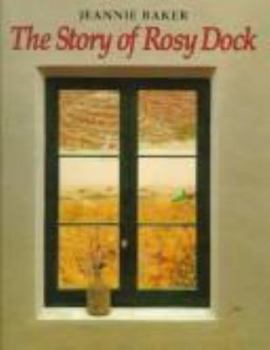The Story of Rosy Dock
Select Format
Select Condition 
Book Overview
The plant rosy dock is not native to Australia. A newcomer who settled in the desert area of central Australia planted it in her garden. After each rare period of rain the desert blossoms, and over... This description may be from another edition of this product.
Format:Hardcover
Language:English
ISBN:0688114911
ISBN13:9780688114916
Release Date:January 2000
Publisher:Greenwillow Books
Length:32 Pages
Weight:0.92 lbs.
Dimensions:0.4" x 8.8" x 11.2"
Age Range:4 to 8 years
Grade Range:Preschool to Grade 3
Customer Reviews
3 ratings
3 1/2 Great Illustrations, But Somewhat Confusing
Published by Thriftbooks.com User , 18 years ago
Author of the celebrated, award-winning "Home," Jeannie Baker uses collages made from photographs to illustate this story of the ebb and flow of vegetation in th Australian desert, corresponding to the "many cycles of rain and drought." THe pictures vividly contrast natural features: The parched land, an oasis, a rainstorm that produces a flood on the formerly dry land, and the resulting profusion of vegetation (and some animals who come to feed on it.) "Rosy Dock" is a plant introduced by settlers about a hundred years ago, and it spreads like a "blanket farther than the eye can see," after a storm. This seems like a good thing, because Baker constructs a vast landscape filled with rosy dock, and fronted by two rabbits at the conclusion. However, in an awkward postscript following the story, Baker informs us that well-intentioned introduction of non-native plants can adversely affect native plants and animals. This short section, like an author's note though not labeled as such, isn't integrated with the story, and may confuse readers who just a page before saw beautiful fields of the plant. The result is an unfocused book, with elements of history, science, and advocacy, but with negligible story elements and an apparently inconsistent point of view. The collage illustrations are striking, and straddle the boundary between photography and drawing. THere's a faux hyper-realism: They're realistic because they're made from photos, but the collage technique gives them a constructed, often 3-dimensional look. The book is best when text and pictures come together to show the sudden rain/drought contrasts, but it doesn't quite show the cohesion needed for story time.
A TRIBUTE TO OUTBACK AUSTRALIA
Published by Thriftbooks.com User , 24 years ago
.Jeannie Baker's books always have a strong underlying environmental theme, but it is never too strident. Instead, she lets her beautiful artwork do most of the talking.In "The Story of Rosy Dock" our focus is drawn to the harsh beauty of the Australian desert. The vivid desert red ochre colors shine out from every page. The level of realism that Jeannie has achieved in her collages tease the eye, with many quirky little details which are almost hiding in the huge landscapes. The highlight of the story is a time when the dryness and harshness of the desert is inundated with rare flooding rains.The human dimension is sensitively handled, where we see the elderly widow rescued from her little shack, when the floodwaters almost cover its roof. There is humour as well, where we see the widow's armchair high up in a dead tree when the floodwaters subside.The sight of a small group of kangaroos and camels marooned on an island of high ground is touching. We see the spectacle of hundreds of pelicans coming up from the coast, seeking out the lakes created by the retreating floodwaters.The environmental message comes through when we recognize the impact of the plagues of rabbits that burrow away in the sandy soil of the desert. The key to the story is the Rosy Dock plant, which was innocently planted by the widow in her precious little garden. This escapes and is propagated all over the countryside. The damaging impact of non-indigenous fauna and flora is a particularly severe problem in Australia.The negative environmental impact of the Rosy Dock is clearly explained in an "afterword" by the author at the back of the book. In brief, it is the power of these introduced species to "change whole landscapes and push many (endemic) plants and animals to extinction"..
Usual high standard from Baker
Published by Thriftbooks.com User , 24 years ago
Jeannie Baker is a collage artist. many are created to illiustrate her children's books, but they also stand alone as works of art, and there are some in art galleries. like 'Where The Forest Meets The Sea' the technique is employed to illustrate an environmental theme - this time the introduction of exotic plant species. This time it is a desert environment of the Finke River. It is a superb introduction to this ecological issue. it is not, however finger-wagging. At the end Baker says: " Throughout the world, often with the best intentions, people introduce plants and animals into a new environment with enormous unforseen consequences. Without their normal predators, some non-native plants and animals multiply so quickly they change the whole landscapes and push many native plants and animals to extinction."Thus Baker seeks to educate and alert us to the problem and raise our awarness so as to avoid the same mistakes in the future.Equally at home as a general reading book, or useful in a primary school science course.






